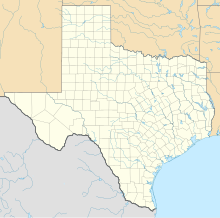Athens Municipal Airport | |||||||||||
|---|---|---|---|---|---|---|---|---|---|---|---|
| Summary | |||||||||||
| Airport type | Public | ||||||||||
| Owner | City of Athens | ||||||||||
| Operator | City of Athens | ||||||||||
| Serves | Athens, Texas | ||||||||||
| Elevation AMSL | 444 ft / 135 m | ||||||||||
| Coordinates | 32°09′49″N 095°49′42″W / 32.16361°N 95.82833°W | ||||||||||
| Map | |||||||||||
| Runways | |||||||||||
| |||||||||||
| Statistics (2023) | |||||||||||
| |||||||||||
Source:
Federal Aviation Administration
[1] | |||||||||||
Athens Municipal Airport is a city-owned public-use UNICOM airport located three nautical miles (6 km) southeast of the central business district of Athens, in Henderson County, Texas, United States. [1] It is mostly used for general aviation.
It is home to the Athens Jet Center which sells aircraft services and aviation and jet fuels.
Facilities and aircraft
Athens Municipal Airport has one asphalt paved runway: 18/36 measuring 3,988 by 60 feet (1,216 x 18 m) [1]
For the 12-month period ending 7 September 2023, the airport had 11,725 aircraft operations, an average of 32 per day: 74% local general aviation, 25% transient general aviation, 1% military, and less than 1% air taxi. At that time there were 27 aircraft based at this airport: 19 single- engine, 4 multi-engine, and 4 jet. [1]
Incidents and accidents
- 11 July 2000: a Cessna T210J, aircraft registration N2244R, was destroyed after a steep nose-up climb and subsequent left-wing-low descent and crash immediately on takeoff from Athens Municipal. The pilot, who was the sole aircraft occupant, was killed. The National Transportation Safety Board (NTSB) attributed the accident to the pilot's inadvertent stall during the takeoff climb. [2]
- 26 July 2008: a Cessna 172, registration N6257E, was badly damaged in a descent and collision with trees immediately after takeoff. The pilot suffered minor injuries, while one passenger suffered serious injuries, and the second passenger suffered minor injuries. The pilot said that the engine had a history of losing power but seemed to be running well after the preflight inspection, and that it had lost engine power during the accident flight; the engine problems could not be duplicated in post-accident testing. Investigators found that the pilot did not hold a valid private pilot certificate nor a valid medical certificate. The NTSB attributed the accident to a partial loss of engine power for undetermined reasons, leading to an uncontrolled descent, and the pilot's improper decision to initiate flight in an aircraft with suspected engine problems. [3]
- 4 March 2009: A man who did not hold a pilot's certificate took off in a Beechcraft Bonanza A36, N5470V, and crashed in a wooded area about 2 mi (3.2 km) from the airport, suffering minor injuries and severely damaging the aircraft. A ground witness saw the man enter the aircraft; believing the entry was not authorized, he telephoned the aircraft owner, who notified police. The accident pilot was in turn arrested by police when he returned to the airport to retrieve his car. The NTSB attributed the accident to the non-certificated pilot's failure to maintain aircraft control. [4]
- 13 September 2014: a parked Cessna Citation I was destroyed in a mysterious nighttime ramp fire. Surveillance footage showed a man entering the jet before it erupted in flames; he was identified by a Bureau of Alcohol, Tobacco, Firearms, and Explosives (ATF) investigator as Raymond Fosdick, who owned a Beechcraft Bonanza seen at the airport on two earlier occasions. Fosdick had seemed unwilling to divulge the reason for one of his earlier visits, arousing the suspicion of a local aircraft shop owner. The Cessna was owned by a corporation controlled by Theodore Robert (T.R.) Wright III, who had flown the aircraft to the airport; the ATF linked Wright to Fosdick through their highly publicized ditching of Wright's Beechcraft Baron in the Gulf of Mexico in 2012, which could not be conclusively investigated because the aircraft was not recovered from the deep water. The ATF found that both aircraft had been insured for substantially more than their recent purchase prices, and a federal court deemed both the crash and fire to be part of a complex insurance fraud scheme organized by Wright. The two men and two associates were convicted in 2017 of conspiracy to commit arson and conspiracy to commit wire fraud. In 2018, Wright was sentenced to 65 months of in federal prison and ordered to pay $988,554.83 in restitution and to forfeit a Learjet he owned, while Fosdick was sentenced to 39 months in federal prison. [5] [6] [7]
See also
References
- ^ a b c d FAA Airport Form 5010 for F44 PDF, effective 7 September 2023
- ^ Aviation Investigation Final Report (Report). National Transportation Safety Board. 26 July 2001. FTW00FA201. Retrieved 26 September 2023.
- ^ Aviation Investigation Final Report (Report). National Transportation Safety Board. 15 April 2009. DEN08LA129. Retrieved 26 September 2023.
- ^ Aviation Investigation Final Report (Report). National Transportation Safety Board. 11 June 2009. CEN09CA186. Retrieved 26 September 2023.
- ^ "Texas pilot who crashed plane into ocean, drove Lamborghini into water sentenced to prison". KLTV. Tyler, Texas. 4 October 2018. Retrieved 26 September 2023.
- ^ Vine, Katy (September 2020). "The Wildest Insurance Fraud Scheme Texas Has Ever Seen". Texas Monthly. Retrieved 26 September 2023.
- ^ Pope, Stephen (1 August 2017). "Young Entrepreneur and Pilot Faces Decades in Prison for Insurance Fraud". Flying. Retrieved 26 September 2023.
External links
- FAA Terminal Procedures for F44, effective April 18, 2024
- Resources for this airport:
- FAA airport information for F44
- AirNav airport information for F44
- FlightAware airport information and live flight tracker
- SkyVector aeronautical chart for F44
